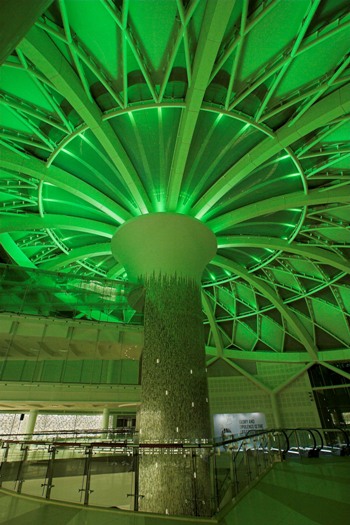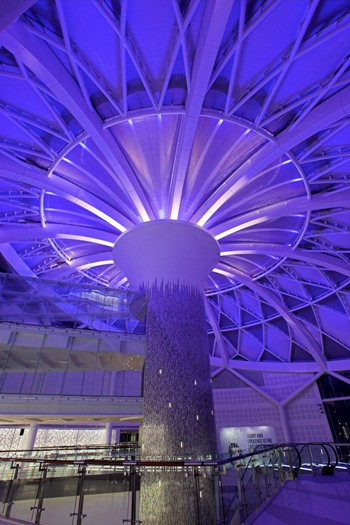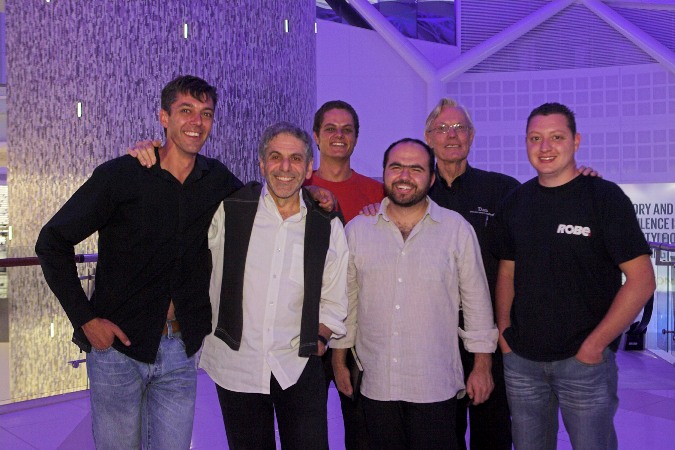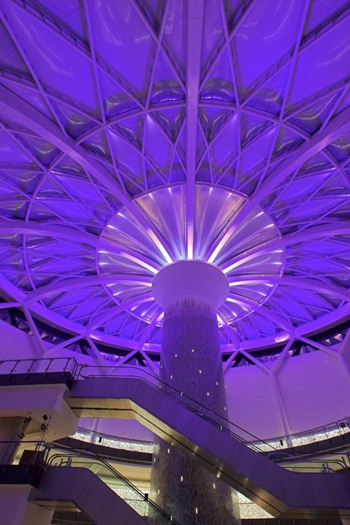05 December 2011


With special thanks to Louise Stickland for article and photos
Protea Court is the newly opened extension to South Africa’s most desirable and glamorous retail destination – Sandton City in Johannesburg.
It features the first ground-breaking architectural lighting installation of its kind in South Africa, designed by Paul Pamboukian and senior lighting designer Joao Viegas of Paul Pamboukian Lighting Design (PPLD), with 115 Anolis ArcPad 48 and 12 ArcSource 96 fixtures used to highlight the spectacular 34 metre high, 42 metre diameter, 11 degree sloping roof structure and its ETFE inflatable skin.
These were supplied by Anolis’ South African distributor DWR, who also undertook the installation and commissioning of the lighting system. DWR’s team of three installation technicians all completed full Rope Access and Working at Height safety courses before starting on site, with approximately 70% of the Anolis fixtures needing to be rigged externally on the roof structure.
Protea Court – which houses 70 new international and luxury retail outlets – was inspired by the shape of South Africa’s national flower, the Protea and designed by Tia Kanakakis from MDS Architects.

Duncan Riley, Paul Pamboukian, Bruce Riley, Joao Viegas (Paul Pamboukian Lighting), Dan Riley & Nick Britz
PPLD has worked with MDS Architects on previous projects, and was asked to create a fabulous and innovative lighting scheme to accentuate the striking shape and aura of Protea Court, in the process capturing the mood and spirit of the whole cutting edge development and retail ‘experience’ with lighting.
PPLD specified ‘green’ lighting technology for several reasons:
Firstly, to match the energy efficient ethos behind the ethylene tetrafluoroethylene (ETFE) roof, a fluorine-based product with high corrosion resistance and strength over a wide temperature range. Just two microns thick, it lets through all natural light, whilst providing very robust insulation. Comprising 146 air-filled cushions, restrained within a network of profiled aluminium extrusions curved to the shape of the steel structure, it is also a first in South Africa.
Secondly, they wanted to ensure that the long-term operational and running costs of the lighting scheme were efficient and budget friendly – so LED was an obvious route.
Thirdly, after exhaustive testing, they knew that using colour changing LEDs would work in the space and also offer additional dynamic, flexible options, e.g. shading the roof differently for special events and occasions. In addition to this, they were convinced that the texture, look and feel of high quality modern LED fixtures was ideal for the application.
 Aesthetically, overall, they wanted the lighting to accentuate the intense verticality of the space and make the strong structural definition of the roof with its beams and girders come alive and ‘breath’. The central lift shaft is based on the idea of the Protea-stem, bursting out at the top into this beautiful petal-like curvature and canopy.
Aesthetically, overall, they wanted the lighting to accentuate the intense verticality of the space and make the strong structural definition of the roof with its beams and girders come alive and ‘breath’. The central lift shaft is based on the idea of the Protea-stem, bursting out at the top into this beautiful petal-like curvature and canopy.
PPLD had not spec’d the Anolis brand before, but once their research into which fixtures would be best to use commenced, DWR – and Dan Riley – was one of the first calls, having heard that Anolis is an excellent quality architectural product.
Fixtures that produced a smooth, rich even coverage with no shadows, pixilation or blockiness across the roof expanse were of paramount importance, and this is one of many areas where Anolis really performs.
They looked at Anolis’s ArcPad 48 RGBWW Integral and ArcSource 96 RGBWW Integral fixtures which were initially demonstrated at DWR’s warehouse. Impressed with the results, further more comprehensive tests were set up on site at Sandton. Their client loved the results as well, and so a lighting scheme utilising Anolis received the green light.
The 115 ArcPad 48 and 12 ArcSource 96s are arranged over three rings around the roof dome, of which a centre cluster of 60 ArcPad 48 Integrals above the top of the lift shaft are the only Anolis fixtures inside the building. Above these – outside – are 12 ArcPad 96s in the centre, plus the other 55 ArcPad 48s on two rings lower down.
They are all optimised to wash the entire roof area complete with its elegant air filled undulations and features. Three very subtle mixed-colour looks are currently programmed as default states, adding finesse and complimenting the huge architectural statement made by the roof itself.
“Using Anolis fixtures and DWR for the installation were definitely the right moves,” confirms Pamboukian, “It all works exactly as I envisioned.”
Dan Riley follows up with, “We are extremely proud to be involved with a project of this stature with such amazing results, and glad to see the equipment specified for all the right reasons.”
 Data is distributed via four LSC DMX splitters, the Anolis units are powered locally and some special ESA Pro Stand Alone PC-based control software was dispatched from the UK, which is programmed to run various programmes from dusk to dawn; slowly changing the accent illumination on the structure, with sporadic colour bursts on the hour and for special events.
Data is distributed via four LSC DMX splitters, the Anolis units are powered locally and some special ESA Pro Stand Alone PC-based control software was dispatched from the UK, which is programmed to run various programmes from dusk to dawn; slowly changing the accent illumination on the structure, with sporadic colour bursts on the hour and for special events.
The biggest physical challenge for the DWR site team of Bruce Riley, Eazy Moketsi and JC du Plessis was the tough working conditions. With very few areas of the roof that could be walked on, most of the rigging was done from the air, an arduous task taking four weeks to complete, and contending with assorted weather conditions – from rain to high winds – all of which interfered with the workflow.
On site, they worked closely with Duane Jolley from contractors WBHO, and DWR was sub-contracted through Vector Foiltech.
Protea Court has already been a massive success, and is one of the most talked about South African business developments of the year.
Everyone is delighted with the lighting scheme. It is hailed as a trend setting phenomena setting new standards and inspiration for others to follow. While it will undoubtedly be emulated, in the meantime PPLD, DWR and Anolis can take the credit for being original and creating a true ‘first’ of its kind in the country.
The project’s joint venture contractors Aveng Grinaker-LTA and WBHO recently took top honours in the annual Southern African Institute of Steel Construction’s 2011 Steel Awards for their role in the project.




